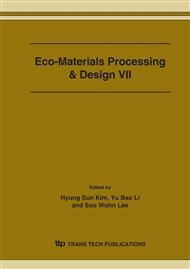p.478
p.482
p.486
p.490
p.494
p.498
p.502
p.506
p.510
Effect of Melt Depth and Nozzle Type on the Mixing Behavior in Bottom-Blown Steelmaking Ladle – A Water Model Approach
Abstract:
It is generally well known that a steelmaking ladle operation plays an important role in the production of clean steel. A turbulent mixing of melt with Ar gas bubbling from the ladle bottom can homogenize a melt temperature and can control precisely chemical compositions of steel. In order to figure out these phenomena, a quantitative analysis of fluid flow behavior of gas and melt during a ladle operation is required and special concerns should be focused on effects of operating parameters on the perfect mixing time of melt. In this study, as a basic approach, effects of operating parameters such as a melt depth (aspect ratio) and a nozzle type (one-hole or porous plug) on the mixing behavior in ladle operation are investigated. Water model experiments are carried out to simulate these melt behaviors in steelmaking ladle. As a result, it was found that there exist an optimized melt depth and a nozzle type at a given gas flow rate, which affect significantly on the mixing behavior of melt.
Info:
Periodical:
Pages:
494-497
Citation:
Online since:
March 2006
Authors:
Keywords:
Price:
Сopyright:
© 2006 Trans Tech Publications Ltd. All Rights Reserved
Share:
Citation:


